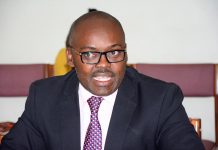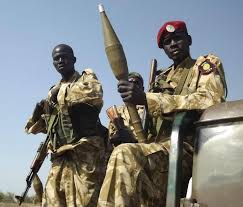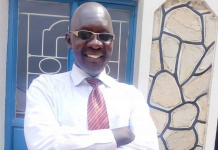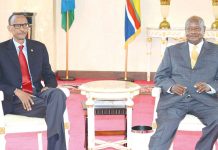For some time, there has been conversation on changing the name of the Sudan People’s Liberation Army (SPLA) to the South Sudan People’s Defense Forces (SSPDF). The conversation which started immediately after independence in 2011 was derived from how different observers saw the new role of the SPLA after independence.
New name adopted at Bilpam Conference
Although such discussions on a new name for the national army were and are still normal, they had not been conclusive until the three day conference of the sixth command council of the SPLA held this week, at which a resolution to change from SPLA to SSPDF was adopted.
The meeting at the military headquarters at Bilpam, Juba, was chaired by President Salva Kiir Mayardit. At least 70 resolutions were adopted and included ways in which the army would become a conventional force. The change of name will however have to go through a constitutional process, in which the SPLA Act of 2009 shall be amended.
New context for national army
The SPLA by name and by its role in history is an institution that retains a strong emotional attachment with the people of South Sudan. It is inconceivable to speak about South Sudan history without some reference to the SPLA.
Through decades of civil war, it was the hope for an oppressed people that the gallant forces of the motherland that became South Sudan, would deliver victory that would offset years of oppression. After independence, the SPLA, its martyrs and living officers justifiably remain heroes in South Sudan.
It is noteworthy that in constructing the SPLA, its founding fathers did not initially envision an army for a separatist country. Hence the acronym did not have a double S that would signify South Sudan. This did not only evoke a legacy of time under North Sudan, it has also given the national army some kind of ambiguity since independence. That is to say, questions are asked as to which Sudan was the national army intending to liberate after independence had been achieved. Further questions included, which liberation was being undertaken after liberation had been achieved? These ideas elicited thoughts that would eventual lead to reform in the name of the national army.
Going back to history over this point, the founding combatants of the SPLA hoped to negotiate for a better status for the people of South Sudan, within a country called Sudan. As the war was prosecuted, this dream did not seem feasible, partly because of how the South was managed by the North of Sudan. When the referendum came to pass, its results resoundingly demanded for separation, and indeed it was granted. Yet still the name of the national army was never changed.
Implications of shift from SPLA to SSPDF
The change of name from SPLA to SSPDF will produce various implications. First of all it will shift the discourse on the national army in South Sudan from the epoch of liberation, which ended to one of national defense which is recurrent. It will also fit the national army in South Sudan into a geopolitical arena in which almost all the East African countries have defense forces as their national armies.
Kenya has Kenya Defense Forces (KDF), Tanzania has Tanzania People’s Defense Forces (TPDF), and Uganda has Uganda People’s Defense Forces (UPDF), while Rwanda has Rwanda Defense Forces (RDF) and Burundi has Forces de Defense Nationale, FDN (National Defense Forces).
Whereas most of the countries in East Africa call their militaries defense forces, South Sudan has opted to choose People’s Defense Forces. This choice could be to avoid being dragged back into history when during the Second Sudanese Civil War (1983-2005) a militia called South Sudan Defense Forces (SSDF) emerged and aligned with the Government of Sudan. Seen then as traitors, the SSDF helped protect the Sudan Armed Forces (SAF) and the oil fields that were still under the control of Sudan. After the Comprehensive Peace Agreement signed on January 9, 2005, the SSDF was integrated into SPLA like many other divergent groups.
South Sudan’s admission to the East African Community as a precursor to SSPDF
Communication from the East African Community (EAC) Secretariat details South Sudan’s admission to the regional body, an important factor in how the new name of the country’s national army was selected.
Republic of South Sudan applied to join the East African Community on 10th June, 2011. A Verification Committee from the EAC visited the Republic of South Sudan from 15th to 31st July, 2012 with the aim of establishing the Republic of South Sudan‘s level of conformity with the criteria for admission of foreign countries into the East African Community as provided under Article 3 of the EAC Treaty.
Based on recommendation of the report by the Verification Committee, the EAC Heads of State Summit in November, 2012 directed the Council of Ministers to negotiate the admission of South Sudan putting into consideration the provision of the EAC Treaty on the criteria of joining the Community.
As a result, the EAC Council of Ministers established a High Level Negotiation Team and negotiation process with the Republic of South Sudan commenced. To initiate this process on the side of South Sudan, His Excellency Salva Kiir Mayardit also appointed a High Level Committee on 13th March, 2014 to oversee South Sudan’s accession to the EAC.
Negotiations between the EAC and the Republic of South Sudan went smoothly culminating in its admission to the EAC by the 17th EAC Heads of State Summit held on 2nd March, 2016 in Arusha, Tanzania. At that Summit, the Heads of State designated the Chairperson of the Summmit, H. E. President Dr. John Pombe Joseph Magufuli to sign the Treaty of Accession with the Republic of South Sudan.
In this regard, H. E. President Salva Kiir and H. E. President Dr. John Pombe Joseph Magufuli signed the Treaty of Accession on 15th April this year in Dar es Salaam, Tanzania. The Republic of South Sudan was given up to 30th of September, 2016 to deposit the instrument of ratification with the Secretary General of the East African Community in Arusha (East African Community Secretariat Communications Office, 2016).
The change of name shall certainly transform how the SPLA as SSPDF shall perform its duties as a security institution. A liberation army has one purpose, to deliver an oppressed community from oppression to liberty and freedoms. With the independence of South Sudan in 2011, this was seen to be the case.
Going forward, the South Sudan People’s Defense Forces (SSPDF) as a new idea will focus on defending the country particularly against external aggression. This implies that the government of South Sudan shall focus resources and capacity of the SSPDF to do this. Key among the reforms shall be to strengthen its air-force, to ensure that it is able to secure South Sudan Airspace, if the air-force remains under the command of the SSPDF. The size and deployments of the SSPDF shall also take this into account, with a more proportionate distribution of its forces along strategic border points.
As the SPLA dwells on national defense, there might be emphasis on the difference between the role of the national police and the defense forces, where the police shall be strengthened to focus on internal security. Currently, SPLA almost takes charge of this role, because the reforms had not reached that stage. Nonetheless there would be close cooperation between the two entities as the government of South Sudan works on delivering security services to the country.
Joel Isabirye is an Assistant Professor of Communication, with South Sudan as one of his research interests.
www.joel isabirye.com





















